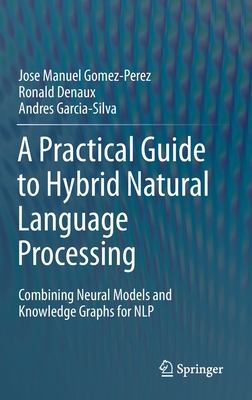Semantic Relations Between Nominals, Second Edition
暫譯: 名詞之間的語義關係(第二版)
Vivi Nastase, Stan Szpakowicz, Preslav Nakov, Diarmuid Ó Séagdha
- 出版商: Morgan & Claypool
- 出版日期: 2021-04-08
- 售價: $3,660
- 貴賓價: 9.5 折 $3,477
- 語言: 英文
- 頁數: 234
- 裝訂: Hardcover
- ISBN: 1636390889
- ISBN-13: 9781636390888
-
相關分類:
Natural Language Processing
海外代購書籍(需單獨結帳)
相關主題
商品描述
Opportunity and Curiosity find similar rocks on Mars. One can generally understand this statement if one knows that Opportunity and Curiosity are instances of the class of Mars rovers, and recognizes that, as signalled by the word on, ROCKS are located on Mars. Two mental operations contribute to understanding: recognize how entities/concepts mentioned in a text interact and recall already known facts (which often themselves consist of relations between entities/concepts). Concept interactions one identifies in the text can be added to the repository of known facts, and aid the processing of future texts. The amassed knowledge can assist many advanced language-processing tasks, including summarization, question answering and machine translation.
Semantic relations are the connections we perceive between things which interact. The book explores two, now intertwined, threads in semantic relations: how they are expressed in texts and what role they play in knowledge repositories. A historical perspective takes us back more than 2000 years to their beginnings, and then to developments much closer to our time: various attempts at producing lists of semantic relations, necessary and sufficient to express the interaction between entities/concepts. A look at relations outside context, then in general texts, and then in texts in specialized domains, has gradually brought new insights, and led to essential adjustments in how the relations are seen. At the same time, datasets which encompass these phenomena have become available. They started small, then grew somewhat, then became truly large. The large resources are inevitably noisy because they are constructed automatically. The available corpora—to be analyzed, or used to gather relational evidence—have also grown, and some systems now operate at the Web scale. The learning of semantic relations has proceeded in parallel, in adherence to supervised, unsupervised or distantly supervised paradigms. Detailed analyses of annotated datasets in supervised learning have granted insights useful in developing unsupervised and distantly supervised methods. These in turn have contributed to the understanding of what relations are and how to find them, and that has led to methods scalable to Web-sized textual data. The size and redundancy of information in very large corpora, which at first seemed problematic, have been harnessed to improve the process of relation extraction/learning. The newest technology, deep learning, supplies innovative and surprising solutions to a variety of problems in relation learning. This book aims to paint a big picture and to offer interesting details.
商品描述(中文翻譯)
機會號(Opportunity)和好奇號(Curiosity)在火星上發現了相似的岩石。一般來說,如果知道機會號和好奇號是火星探測車(Mars rovers)的類別實例,則可以理解這個陳述。這表明,正如「在(on)」這個詞所暗示的,岩石(ROCKS)位於火星(Mars)上。理解的過程中有兩個心理操作:識別文本中提到的實體/概念之間的互動,以及回憶已知的事實(這些事實通常本身就是實體/概念之間的關係)。在文本中識別的概念互動可以添加到已知事實的庫中,並幫助處理未來的文本。累積的知識可以協助許多高級語言處理任務,包括摘要、問答和機器翻譯。
作者簡介
Vivi Nastase, University of Stuttgart
Vivi Nastase holds a Ph.D. from the University of Ottawa. A research associate at the Univer sity of Stuttgart, she works mainly on lexical semantics, semantic relations, knowledge acquisi tion, and language evolution.
Stan Szpakowicz, University of Ottawa
Stan Szpakowicz holds a Ph.D. from Warsaw University, and a D.Sc. from the Institute of Informatics, Polish Academy of Sciences. Now an emeritus professor of Computer Science at the University of Ottawa, he has dabbled in NLP since 1969. His interests in the past several years include semantic relations and lexical resources.
Preslav Nakov, Hamad Bin Khalifa University
Preslav Nakov holds a Ph.D. from the University of California, Berkeley. He leads the Tanbih mega-project, developed in collaboration with MIT, which aims to limit the impact of fake news, propaganda, and media bias.
Diarmuid Ó Séagdha, University of Cambridge
Diarmuid Ó Séagdha holds a Ph.D. from the University of Cambridge. He works for Apple, and is a Visiting Industrial Fellow at the UC’s NLIP Research Group. His interests revolve around the application of machine learning techniques to semantic processing tasks.
作者簡介(中文翻譯)
維維·納斯塔塞,斯圖加特大學
維維·納斯塔塞擁有渥太華大學的博士學位。她是斯圖加特大學的研究助理,主要研究詞彙語義、語義關係、知識獲取和語言演變。
斯坦·斯帕科維奇,渥太華大學
斯坦·斯帕科維奇擁有華沙大學的博士學位,以及波蘭科學院資訊學研究所的科學博士學位。現為渥太華大學計算機科學的名譽教授,自1969年以來一直涉足自然語言處理(NLP)。他近幾年的研究興趣包括語義關係和詞彙資源。
普雷斯拉夫·納科夫,哈馬德·本·哈利法大學
普雷斯拉夫·納科夫擁有加州大學伯克利分校的博士學位。他領導與麻省理工學院合作開發的Tanbih大型專案,旨在減少假新聞、宣傳和媒體偏見的影響。
迪爾穆伊德·奧·西亞達,劍橋大學
迪爾穆伊德·奧·西亞達擁有劍橋大學的博士學位。他在蘋果公司工作,並擔任加州大學NLIP研究小組的訪問工業研究員。他的研究興趣圍繞機器學習技術在語義處理任務中的應用。
目錄大綱
Introduction
Relations Between Nominals, Relations Between Concepts
Extracting Semantic Relations with Supervision
Extracting Semantic Relations with Little or No Supervision
Semantic Relations and Deep Learning
Conclusion
Bibliography
Authors' Biographies
Index
目錄大綱(中文翻譯)
Introduction
Relations Between Nominals, Relations Between Concepts
Extracting Semantic Relations with Supervision
Extracting Semantic Relations with Little or No Supervision
Semantic Relations and Deep Learning
Conclusion
Bibliography
Authors' Biographies
Index












